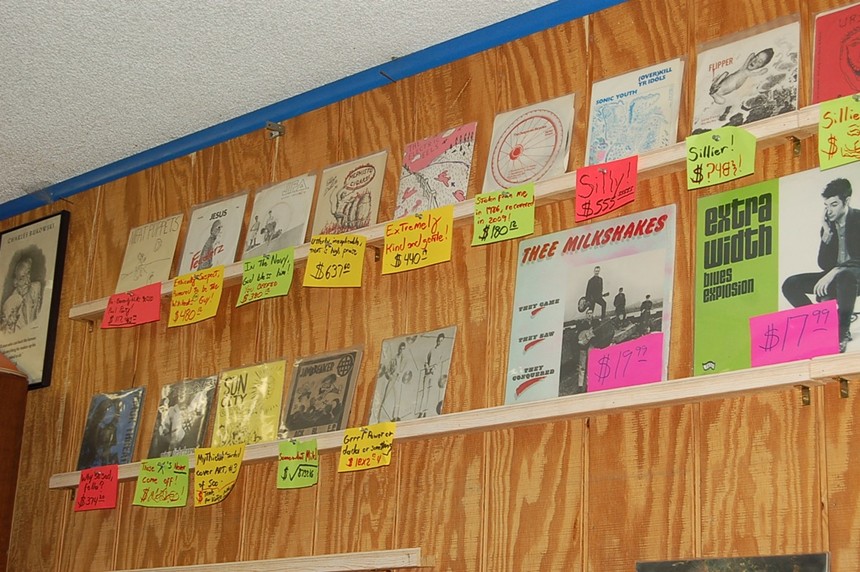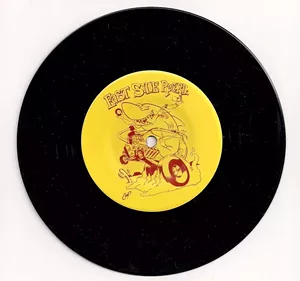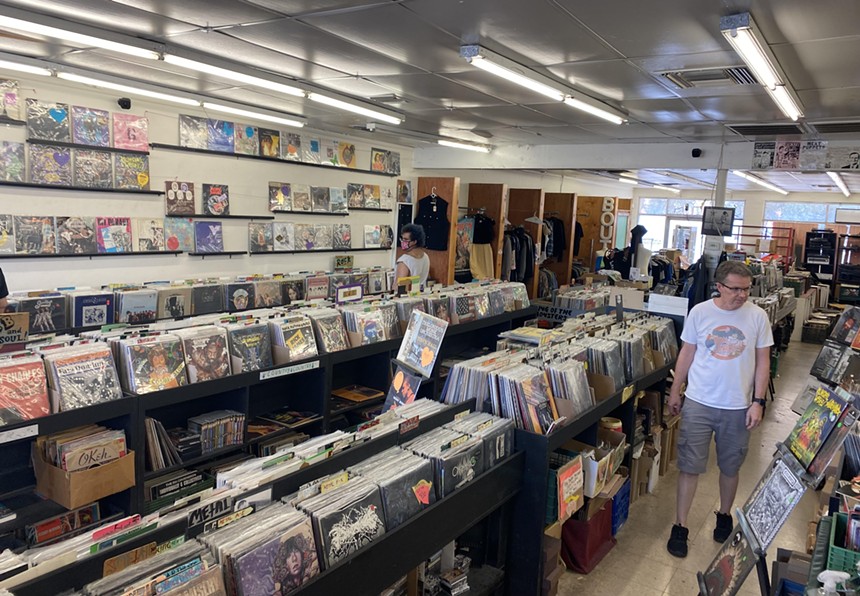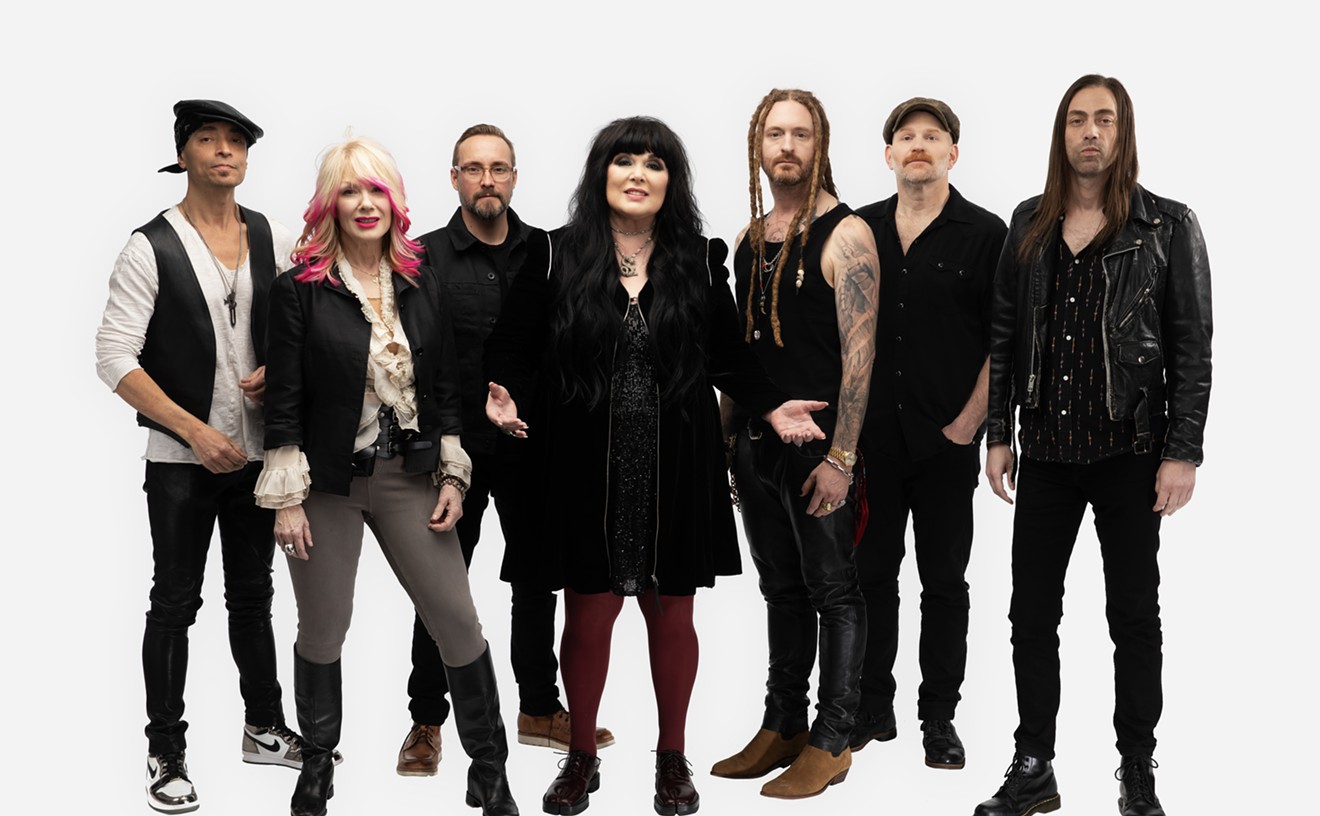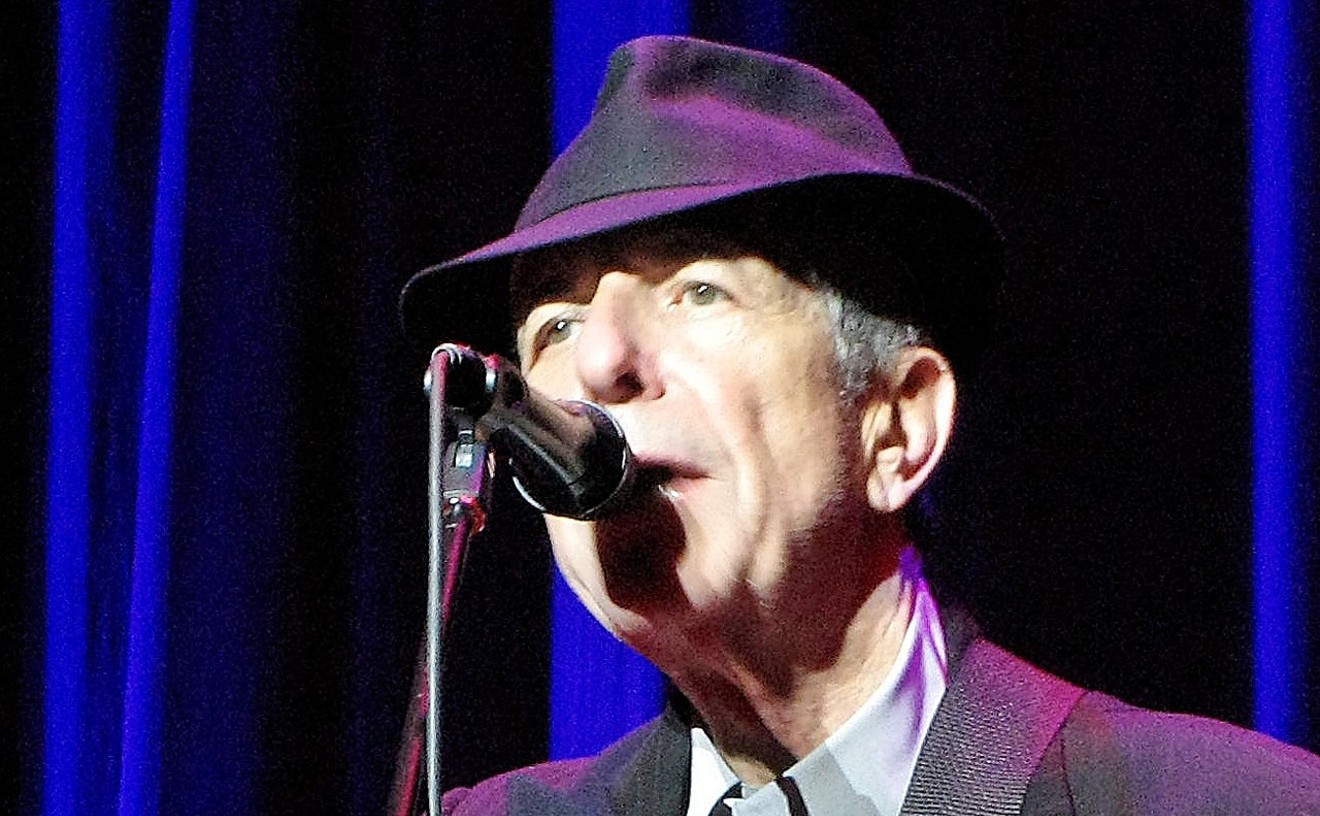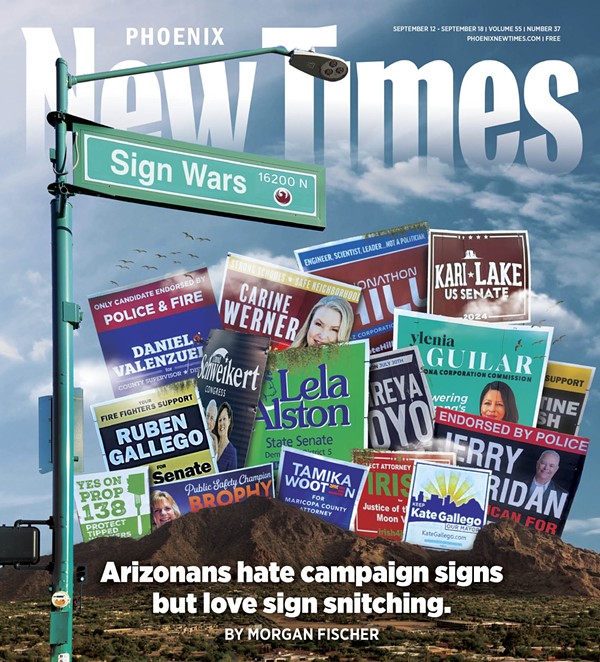The same can't be said for the store's owner, Michael Pawlicki, who looks sweaty, disheveled, and wiped out by the heat. At the moment, he's all smiles and doing what he loves: talking music and selling records.
As the 60-year-old is ringing up a customer's stack of records, Pawlicki pauses to comment on one of the selections. "Michael Bolton, huh? An inspired choice," he says dryly.
The customer, a local DJ, shrugs and says the singer's 1989 album, Soul Provider, is perfect for his Sunday brunchtime session at a CenPho eatery. "I spin Bloody Mary music, so it's going to fit right in," he says.
Pawlicki's seen countless questionable choices cross his register in the four decades he's been selling music. For the last 35 years, it's been behind the counter of the Ghost of Eastside Records, formerly known as just Eastside Records.
The now-legendary store was launched in July 1987 by co-founders (and former Zia employees) Ben Wood and the late Clayton Agent at small Tempe plaza on University Drive and Ash Avenue. Pawlicki, also a Zia alum, came on board soon after. Over the next two decades, Eastside Records became beloved by vinyl geeks, punks, and music fans for its diverse selection of music, knowledgeable staff, and laidback vibe.
During the '90s and 2000s, it was a cultural hub and meeting ground for many, a source of underground culture, and a scrappy alternative to spots like Stinkweeds or chains like Zia. The heart and soul of the store has been Pawlicki, who started as a clerk and eventually became its owner. The store has been through death and rebirth over the past 35 years, having closed its original location in 2010 before being reincarnated as The Ghost of Eastside Records as a series of pop-ups before settling down in Tempe's Danelle Plaza in 2013 as a part of the Double Nickels retail cooperative.
Music fans and vinyl junkies across the Valley have an Eastside story, including tales of wild shows, weird characters, or rare finds. Many were willing to share them with Phoenix New Times for a compilation of memories in celebration of the store's 35th anniversary this month.
Back in the mid-'80s, Eastside Records co-founders Ben Wood and the late Clayton Agent were working for the Valley's growing Zia Record Exchange retail chain along with Michael Pawlicki. By early 1987, though, Wood and Agent left the company. In July, they opened Eastside.
Michael Pawlicki, owner of The Ghost of Eastside Records: We were managing the three separate Zia stores at one point. [The late Brad Signer, Zia's founder] was grooming me for more of a [general] managerial person, which was not me. I was more of an underground person who didn't want to manage a chain. Ben and Clayton split off and started Eastside.
Ben Wood, co-founder of Eastside Records (in 2010): Michael and I worked at Zia together. And he's such a smart and nice guy, we wanted to bring him on.
Pawlicki: They called and asked if I'd wanted to work for them and offered me double my Zia salary.
Wood: I wanted it to be a fun place to work. That was super important to me. When you're selling a beloved art form, you should have a comfortable, fun environment.
Pawlicki: There wasn't much to the space. It was small [with] wood paneling everywhere. It was very catch-as-catch-can. Most of what was inside had been donated by other stores. The bins were from Tower [Records]. Divider cards were from other places.
Bob Schriner, patron and former employee: When I first went in, it was primarily vinyl. The bins [for 7-inch] records were always in that same place. I remember making my way through seven-inches first and then to the [LPs]. Those days, there weren't really genre sections either. Everything was just put together so you might flip from Maceo Parker to Pere Ubu.
Pawlicki: Zia and Tower Records were also nearby and Roads to Moscow was still around on Mill [Avenue], but probably on its last legs. They'd been principally a punk place. We had punk but we were also selling lots of reggae and ordering a zillion Grateful Dead CDs. Clayton was a big Deadhead.
Kevin Daly, guitarist, Grave Danger: Each of the record stores around there had a different flavor and influence. College kids were at Zia. But at Eastside, it was more loose [and] friendly.
Michael Pistrui, guitarist, Beats the Hell Out of Me/Fat Gray Cat: I knew Ben from Zia and when Eastside opened, I started going there. Shows were chaotic because the bands played right up against the record bins in the aisles; wherever they could fit in.
Pawlicki: The first show we did was in '87 or '88. The Sun City Girls did a thing with an avant-garde saxophonist who was coming to town. The Dwarves were in town the same night and no one would do their show. They had a bad reputation as troublemakers. They show up and [frontman] Blag Dahlia starts tapping me on the shoulder every three minutes asking to play. And I'm like, "You guys just phoned me. You play when everyone's done." Minutes later, he asks again. When they start playing, after two minutes he grabs a broken black-and-white TV from under the bins to smash it. I ran over and grabbed him. Ben and Clayton looked horrified and things got nuts.
Wood: A friend of mine basically put [Blag] into a professional wrestling move, what many will know as the suplex, right over the drum kit.
Chaotic shows and fun times were built into the DNA of Eastside Records and continued into the early '90s and beyond.
Cris Kirkwood, bassist, Meat Puppets (in 2010): Anything could happen at Eastside and often did. My memories of the place are nothing but fun. One night [32] years ago, me and Ben were getting drunk at his house and wound up at the store hanging those dinky-winky Mexican figurines.
Pawlicki: If we were there late nights and working after hours, we'd drink and get sillier.
Schriner: And it ruled. The door was locked, drinks in hand. It was like a bar. If the folks running it [liked] you, they close up and let you stick around.
Drew Ramsey, longtime patron and former employee: It was a social hub. Nobody ever suggested, "Let's hang out at Zia." And Michael and the staff were personable and knowledgeable about all of the music. It just lent itself to be that hangout and record store of choice. It was a social center for everybody in my sphere. Even in the years before I worked there, we'd just spend hours at the store on weekend nights.
Kirkwood (in 2010): Eastside has always been a cool counterpoint to places like Zia for music, a personality-driven place where the guys working there are like institutions themselves. People like Mike were built for that place.
And if you hung out at the store long enough, you might've gotten a job.
Schriner: I spent so much time at Eastside. It was kind of one of those things where it's like, you're here enough to work here, you might as well start working here.
Pawlicki: [Former co-owner and employee] Steve Gastellum started working with us in '92 or '93. He knew jazz, reggae, and a lot about all music. He has a real high-level knowledge and brought a lot to the store.
Scott Holman, longtime patron: All those guys at Eastside had impeccable taste in music and helped cultivate so many people's interest in music. So when they opened, I just remember loading up on all kinds of stuff: a lot of jazz, a lot of soul, R&B, first pressing of Funkadelic records. There was no Discogs back then, so they didn't price them aggressively.
Brodie Foster Hubbard, longtime patron: In high school, I was a regular. One day, I was really interested in a Minor Threat CD, but was hedging about buying it when Bob Schriner said, "Why don't you just take it on me?" Okay, thanks!
Matt Martinez, bassist: I first went there in high school. I remember being exposed this stuff I'd only read about in fanzines like Flipside or Maximum Rocknroll. We're talking pre-Internet before we had access to every scrap of knowledge. It all came down to selection. There were contemporaries like Stinkweeds and, to certain extent, Zia, that got some titles, but Eastside tapped more of the punk rock/hardcore/garage rock, jazz, and reggae. They were also one of the first early adopters of European black metal [in the mid-'90s].
Jim Mahfood, artist and former Valley resident: I'd say it was a critical hub for spreading music and culture because the guys that worked there, especially Mike, would notice what I was buying and they'd go out of their way to say, "Oh hey, if you like this, you should check out this." They turned me on to a lot of music I wasn't even aware of. There'd be times I'd roll in there with Z-Trip or another DJ and everyone would want to hang out and talk music, talk records.
Hubbard: I hung out with a bunch of Tempe people at punk and hardcore shows. That whole area was the countercultural hub of the Tempe scene. Shows at Tempe Bowl or Electric Ballroom, house shows. And kind of the thing at the time was you either hang out at Casey Moore's or you go to Eastside and find out where the party was happening.
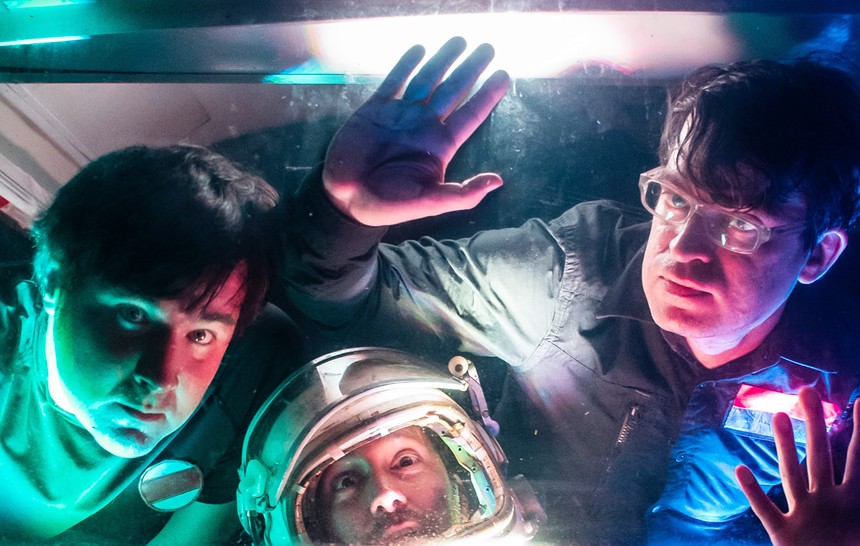
Rock band Man or Astro-Man? played a wild show at Eastside Records in 1995.
Mike White/Wikimedia Commons
Brian Teasley, guitarist, Man or Astro-Man? (in 2013): Ben wanted to do it. He did a Servotron 7-inch as well. It was cool. I think a lot of the groundwork Ben had done for us [in Phoenix] before or after he did the 7-inch with him. It was cool because it was so organic.
Wood: Coop designed the label logo. A shark in a hotrod.
Teasley (in 2013): My favorite show that we ever did in Phoenix was at Eastside Records [in the mid-1990s] when it was like 120 zillion degrees. Hundreds of kids showed up and it was so crazy, so much fun. It was like pass-out-from-heat-exhaustion kind of hot, but that was probably my favorite thing we did there. I think partly it was the unpredictability of it. I think no one really knew that so many people were going to show up. You think of a typical in-store, where a band plays five songs and it never has the energy of a real show. And in this case it ended up being, like, such an impromptu thing.
Pawlicki: We'd expanded to double our size around then, but it was almost solid people all the way through. I remember enough that there was people on the counters and people standing on the edge of bins so they could see over the crowd. The place was packed. Our landlady was pissed afterward and banned shows there [for years].
New generations of music fans constantly discovered Eastside. They weren't the only visitors, as neighborhood characters and famed musicians would stop in.
Mahfood: I moved to Arizona in '97 or '98 and I'd come to Eastside a couple times a week, buying CD and records, and becoming friends with Mike and Ben. They started carrying my self-published mini-comics and zines and stuff. And all the money would go back to the store to feed my record habit.
Ryan Avery, patron and musician: I'd discovered it through my friend Lena and I remember being blown away by the punk and ska selection they had. Just excited by the way they did everything with the [bin] dividers being hand-drawn or having old Japanese toys like [Shogun Warriors] by the ceiling. The music they were listening to was always cool and interesting.
Emily Spetrino, patron: With kids my age, Stinkweeds was for the indie kids but the punks would go to Eastside, which were more of who I was hanging out with and ended up there often. Mike and everyone else working there were super-chill with letting a bunch of weird teenagers hang out there all the time.
Schriner: Sonic Youth paid us a visit on their Neil Young tour. One of his fans complained about Sonic Youth in front of them. Michael told the guy he could pass on his feedback directly.
Martinez: You had this menagerie of interesting people coming in. Personalities, characters, street performers, and unhoused, and characters. William Wonderful, this street poet, was always in there. This guy Pepto would stick his head in and joke, "This is a robbery!" and everybody laughed. It was a place for the fringe, the alternative culture. People would cruise Mill, hang out at Java Road or Coffee Plantation, and hit Eastside.
In November 2010, Eastside's owners announced the store would shut its doors the following month. As Wood told New Times prior to the closure, it was largely because of Pawlicki's decision to leave town in favor of opening a record store in another state. Eastside had weathered the financial upheaval the music industry endured in the 2000s, including reducing the size of the store in 2005 to cut costs, but it wore down the store's owners.
Wood (in 2010): We [survived] because we still had it in us, but the minute Mike said he was leaving, and wasn't going to spend another summer here, it was like, "It's time to go." A lot of other circumstances led up to it, like the fact some months we'd break even and some months I'm paying a little bit of money to stay open. Our landlady also wanted me to sign a big lease with the store, which I wasn't going to do.
Pawlicki: When the music business kinda hit a pinnacle [in 2000] and went over a hump with all the downloading, it [was] a rougher game. Closing became a constant discussion. [We'd] come close a couple times, where for two or three weeks we didn't know if we were going to stay open.
Wood (in 2010): And it got to the point ...that, yeah, we could stay open, but we'd have to sell a bunch of shit we don't like. None were willing to do it. At a certain point ... it's kind of like putting Old Yeller down.
James Fella, musician and founder of Gilgongo Records: It was really sad. Everybody loved that place.
Eastside's original location wrapped up its run with two farewell shows in late December 2010. The first happened the night before Christmas Eve with sets by Grave Danger, Space Tourists, and Garage Shock. A second gig followed a week later with music from Fella's band Soft Shoulder and other local acts.
Daly: It's terrible to lose a business like that, but that night was a blast. We just went off. To me, it was hallowed ground because so many people had played there.
Fella: The night that final show happened, we shot a video and at the end of our set, the camera pans around and you see these bare walls and all these people crammed inside watching. Everyone suspected Michael was going to make something else happen at another location. We just didn't know when.
Turns out, it was only a year. In December 2011, Pawlicki launched a pop-up called The Ghost of Eastside Records inside a backroom at Tempe's Danelle Plaza. It was meant to last six months or less where he'd sell off leftover stock from the original Eastside, as well as a hoard of vinyl he'd accumulated since its closing.
True to his word, the pop-up closed the following spring when Pawlicki's wanderlust and the Arizona heat returned. He spent summer 2012 looking for retail space out in L.A. When his hunt proved fruitless, Ghost of Eastside Records began haunting a new pop-up location on Forest Avenue near Arizona State University's main campus in Tempe.
Fella: The first [pop-up] did feel small and a little temporary, as did the one up by ASU. They didn't seem as concrete as the original location or where he wound up going next.
By fall 2013, the Ghost of Eastside Records found a permanent home when Pawlicki joined up with other indie artists and record stores to create the Double Nickels Collective, a co-op retail space at Danelle Plaza. It's remained there ever since.
Pawlicki (in 2013): I'd seen it in other cities and wanted to try something different. Almost like an antique mall but geared toward younger people of that culture. Just throw all sorts of crazy stuff into one place and see how it flies.
Fella: Wherever Mike goes, the store and the vibe goes with him. He's an eccentric person. He loves what he does. He invests himself probably more than anybody should and I think the store's a reflection of him. It's wild, it's a little out of control, it's messy.
Holman: When I come back to town, I always see Michael, because it's such a spiritual experience to hang out like old times. You walk in, there's death metal or punk playing and Michael's just carrying on a conversation about politics. It's beautiful. I always go home with like 20-30 records.
Pawlicki: I don't know if I'd say I'm living the dream, but I've had a lot of fun. You don't make a lot of money. As capitalists go, I'm really shoddy. I pay more than anyone in town and I sell for less. That's not a great business model, but I've enjoyed doing this and still do to this day.
Editor's note: Some quotes have been condensed for brevity and clarity.




